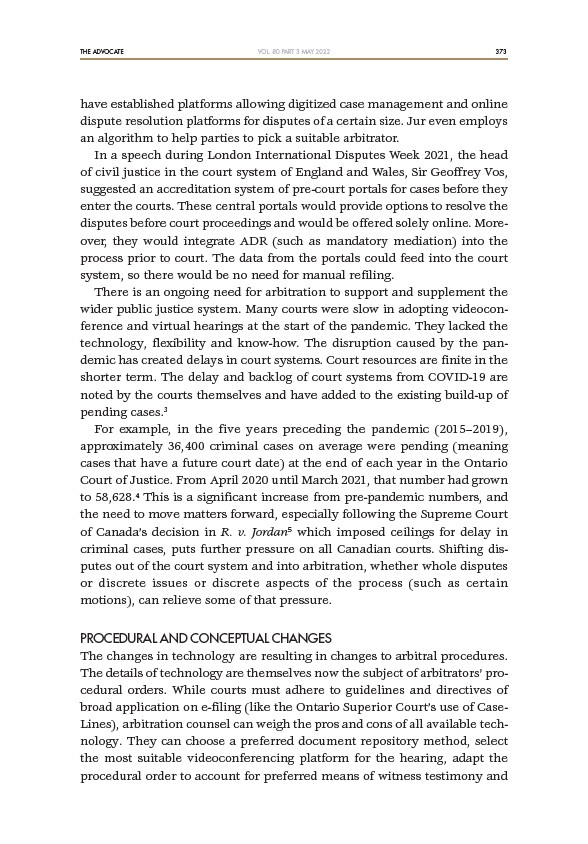
THE ADVOCATE 373
VOL. 80 PART 3 MAY 2022
have established platforms allowing digitized case management and online
dispute resolution platforms for disputes of a certain size. Jur even employs
an algorithm to help parties to pick a suitable arbitrator.
In a speech during London International Disputes Week 2021, the head
of civil justice in the court system of England and Wales, Sir Geoffrey Vos,
suggested an accreditation system of pre-court portals for cases before they
enter the courts. These central portals would provide options to resolve the
disputes before court proceedings and would be offered solely online. Moreover,
they would integrate ADR (such as mandatory mediation) into the
process prior to court. The data from the portals could feed into the court
system, so there would be no need for manual refiling.
There is an ongoing need for arbitration to support and supplement the
wider public justice system. Many courts were slow in adopting videoconference
and virtual hearings at the start of the pandemic. They lacked the
technology, flexibility and know-how. The disruption caused by the pandemic
has created delays in court systems. Court resources are finite in the
shorter term. The delay and backlog of court systems from COVID-19 are
noted by the courts themselves and have added to the existing build-up of
pending cases.3
For example, in the five years preceding the pandemic (2015–2019),
approximately 36,400 criminal cases on average were pending (meaning
cases that have a future court date) at the end of each year in the Ontario
Court of Justice. From April 2020 until March 2021, that number had grown
to 58,628.4 This is a significant increase from pre-pandemic numbers, and
the need to move matters forward, especially following the Supreme Court
of Canada’s decision in R. v. Jordan5 which imposed ceilings for delay in
criminal cases, puts further pressure on all Canadian courts. Shifting disputes
out of the court system and into arbitration, whether whole disputes
or discrete issues or discrete aspects of the process (such as certain
motions), can relieve some of that pressure.
PROCEDURAL AND CONCEPTUAL CHANGES
The changes in technology are resulting in changes to arbitral procedures.
The details of technology are themselves now the subject of arbitrators’ procedural
orders. While courts must adhere to guidelines and directives of
broad application on e-filing (like the Ontario Superior Court’s use of Case-
Lines), arbitration counsel can weigh the pros and cons of all available technology.
They can choose a preferred document repository method, select
the most suitable videoconferencing platform for the hearing, adapt the
procedural order to account for preferred means of witness testimony and